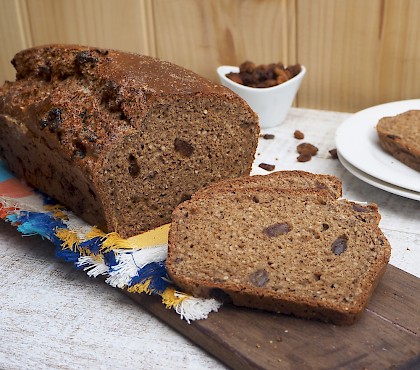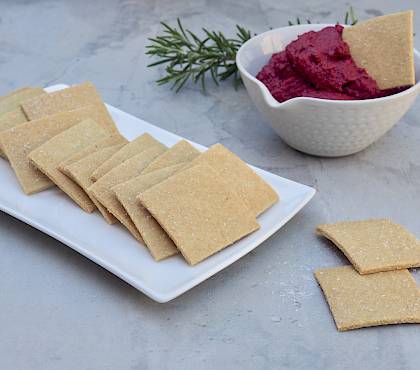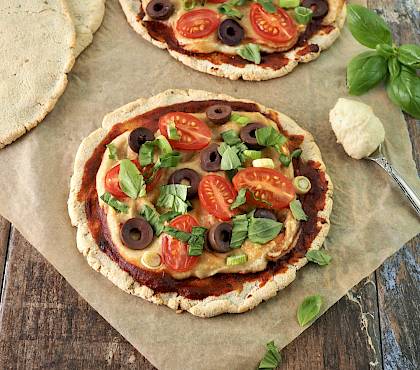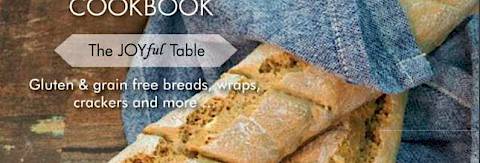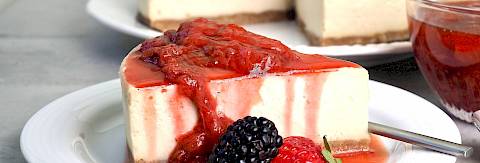
Hot Cross Buns
- Serves: 10
- Prep Time: 00:25
- Cooking Time: 00:25
Hot Cross Buns have always been a tradition at Easter time in our home but the muffin style I usually made wasn't popular with my hubby. He wanted them to look like real buns but still be healthy and flavoursome. The addition of psyllium husk powder to the recipe has helped make the mixture hold together well to shape into buns, plus a couple of other tweaks. Sometimes it's not always good that he likes a recipe this much, they just don't last but I'm glad they freeze well to hide.
Ingredients
* Please click on the green icon next to the ingredients listed below for extra details and helpful information.
- 3 lge egg(s)
- 1 sml - med ripe banana(s), (you can't taste the banana in the buns)
- 1/4 cup macadamia oil, or oil of choice
- 3 Tbsp honey (unprocessed)
- 1 tsp apple cider vinegar
- 2 1/4 cups almond meal/flour
- 1 cup arrowroot flour, or tapioca
- 2 Tbsp psyllium husk powder, (not husks/flakes)
- 1 Tbsp fine orange zest, or 6 drops wild orange essential oil (I use doterra)
- 1 Tbsp cinnamon
- 2 tsp mixed spice
- 1/2 tsp nutmeg
- 1 tsp baking powder (gluten free)
- 1 tsp baking soda (bicarb)
- 1/4 tsp fine sea salt
- 1/2 cup sultanas (organic)
- 4 lge Medjool date(s), pitted and diced
- CROSSES:
- 3 Tbsp arrowroot flour, or tapioca
- 2 Tbsp almond meal/flour
- 1 1/4 - 1 1/2 Tbsp filtered water
- GLAZE (OPTIONAL):
- 1 Tbsp honey (unprocessed)
- 1 Tbsp filtered water
- 1/4 tsp cinnamon
Directions
Preheat oven to 170c (fan-forced). Line a baking tray with baking paper.
Add the eggs, banana, oil, honey and vinegar to a food processor. Process for 10 seconds or until combined.
Add the almond meal, arrowroot, psyllium powder, zest or essential oil, spices, baking powder, soda and salt to the wet ingredients. Process for 5 seconds, scrape down sides of the bowl and then process for a further 15 seconds.
Remove the blade and use a spatula to mix the sultanas and dates evenly through the mixture. Allow the mixture to sit for 5 minutes to thicken further.
Scoop out 10 equal portions of the mixture using a spatula and place onto the prepared tray. Leave a slight gap between each portion (they will rise and fill the space when cooking). Use damp fingers to smooth and shape the portions to look like buns.
Bake for 15 - 18 minutes or until risen and just starting to lightly brown. Remove buns from the oven and pipe over the crosses (see notes below) and return to bake for a further 10 minutes or until lightly golden and a skewer inserted comes out clean. (The inside will be a little darker in colour than store-bought buns, we have delicious spices in these buns).
To make the crosses: You need a thick paste. Add the arrowroot and almond meal to a cup or small bowl and stir. Add 1 tablespoon of water and mix well, then add extra water by the teaspoon to create a thick paste (just an extra few drops can make it too runny). Spoon or pour into a piping bag or snip the corner off a snap-lock bag. Pipe lengthways in one continuous line over the buns and then across (hold the end to stop the paste dripping as you change direction).
Glazing the buns (optional): Glazing makes the buns shine and look more like shop bought but not necessary. Heat the honey, water and cinnamon together. Once the buns have cooled slightly, use a pastry brush to add a thin coat of syrup.
Serve warm with organic butter (if tolerated) or ghee, they are best eaten on the day or rewarmed, also delicious sliced and toasted. They can be stored frozen with the glaze on or left to coat once thawed and warmed before serving.
You may also like
egg(s)
I have used large free range or organic eggs from a 700g carton in my recipes. Eggs are one of the few foods considered to be a complete protein because they contain all 9 essential amino acids, also studies have shown that lutein (yellow colour) in egg yolks protects against the progress of early heart disease.
banana(s)
In a paleo diet it's best to eat bananas in moderation. They are excellent to use to naturally sweeten a recipe and then you can reduce or eliminate other sweeteners. Bananas are a very good source of vitamin B6, manganese, vitamin C, potassium, dietary fiber potassium, copper, so you can see they are healthy but I find it's best just no in large qualities due to their high natural sugars.
macadamia oil
Macadamia nut oil is the non-volatile oil expressed from the nut meat of the macadamia tree, a native Australian nut. I avoid heating to very high temperatures but use it extensively for grain free baking at lower temperatures in the oven. Delicious over salads and it's also one of the healthier nuts, as it's higher in Omega 3 oils than other nuts.
honey (unprocessed)
Use unrefined or raw honey. It is the most common natural sweetener in my recipes. It's best to buy local unprocessed honey as it has wonderful health benefits and can help with allergies. Generally honey sold in supermarkets has been processed. Honey possesses antiseptic and antibacterial properties.
apple cider vinegar
Apple Cider Vinegar is used extensively throughout my recipes due to its health benefits. When purchasing, look for raw unfiltered apple cider vinegar ‘with the mother’ it has a cloudy appearance. Avoid malt vinegars as they are made from barley and contain gluten.
almond meal/flour
The most favoured gluten/grain free flour substitute in my kitchen is almond meal. It is finely ground blanched almonds and is also known as almond flour. It has a slightly sweet flavour so you don’t have to add as much sweetener when baking with it. Almond meal/flour is rich in manganese which helps the body heal after injuries and also helps the body break down carbohydrates. Almond flour is also rich in magnesium, which can help control your blood sugar levels. It's rich in vitamin E and other antioxidants, which may help reduce the risk of serious health conditions like cancer, diabetes, stroke, and heart disease. Almonds are also a good source of calcium.
All kinds of nuts can be ground down to make a meal and are excellent for raw cheesecake or pie bases. Nut meals/flours are best stored in airtight containers in the fridge or freezer to prevent them going rancid.
arrowroot flour
Arrowroot is a herb, the roots are cultivated for its starch properties. It is used in my recipes as a thickener and I also like combining it with almond meal to produce a much lighter texture, more like a gluten flour. I find the starch helps to bind the ingredients together. You can substitute tapioca flour, which is made from the dried roots of the cassava plant. Tapioca can be used in baking, it has a slightly sweet flavour. However, I do not recommend thickening with tapioca, as it has a stretchy, gummy texture. Supermarkets only sell in very small containers, which is not cost effective. Purchase from baking specialty stores, health food stores or online. ( When substituting for cornflour in recipes, 2 teaspoons arrowroot = 1 tablespoon cornflour/starch).
psyllium husk powder
Psyllium powder is ground down psyllium husks to produce a very fine powder. Psyllium is a source of soluble dietary fibre, it expands when mixed with liquid. It can help relieve constipation and diarrhea. Psyllium is used in gluten free baking, as the finely ground husks bind moisture and help make breads rise and less crumbly. You can purchase psyllium husk powder from a supermarket or make your own by using a blender or food processor to ground to a very fine powder.
orange zest
The orange is a fruit from the citrus family. Orange zest is the finely grated skin from the outside of the orange but doesn't include the white pith which is bitter. The skin contains the orange oil which gives a stronger flavour when added to cooking. Use organic and locally grown if possible, scrub orange skin before using.
cinnamon
I am sure you will notice as you read my recipes that cinnamon appears quite frequently. It lends itself to savoury and sweet dishes. I have used ground cinnamon in my recipes if not stated otherwise. The best cinnamon to use is Ceylon (Verum). It has huge health benefits in regulating blood sugar levels. Cinnamon has antifungal properties and candida (yeast overgrowth) cannot live in a cinnamon environment. Added to food it inhibits bacterial growth, making it a natural food preservative and these are just a few of the benefits.
mixed spice
Mixed spice is a blend of sweet spices. Cinnamon is the dominant flavour, with nutmeg and allspice, some brands may also contain cardamom. It is called pumpkin spice in the USA. It is often used in the baking of sweet foods and fruits.
nutmeg
Nutmeg is the seed kernel of the fruit-nutmeg. The seed is dried and ground. It is one of the highly prized spices known for its aromatic, aphrodisiac and curative properties. Nutmeg is a good source of minerals like copper, potassium, calcium, manganese, iron, zinc, and magnesium.
baking powder (gluten free)
Baking Powder is a rising agent for baked goods. If substituting for baking soda you will need 4 times the quantity. Ensure you purchase a gluten free, no aluminum brand. Alternatively, you can make your own baking powder; 1 teaspoon of baking powder is equal to 1⁄4 teaspoon of baking soda and 1⁄2 teaspoon of cream of tartar. Note, that they should only be combined when preparing your recipe.
baking soda (bicarb)
Also known as Bicarbonate of Soda or Sodium Bicarbonate and is used as a rising agent in baking, it contains no gluten or grains. I use Bob's Red Mill baking soda as I find it rises better than other brands I've tried.
sea salt
Organic unbleached, unrefined organic Celtic sea salt or pink Himalayan salt is my salt of choice as these contain healthy minerals and trace elements that our body needs. Regular table salt has been bleached, refined and processed leaving minimal health benefits. If you choose to use regular table salt in my recipes you will need to reduce the quantity or the end result will be to salty.
sultanas (organic)
The sultana is a pale green oval seedless grape which has been dried. Sultanas are sweet and used in baking and eaten as a snack. Purchase naturally dried, preservative and oil free sultanas, organic is best.
Medjool date(s)
I use Medjool dates in my recipes, I like the flavour and softness of these dates. A bonus, there are no preservatives used with these dates. They blend easy when adding to recipes and give a slight caramel flavour.
Medjool dates are an excellent source of dietary fiber, rich in potassium, copper, manganese, magnesium and vitamin B6.
arrowroot flour
Arrowroot is a herb, the roots are cultivated for its starch properties. It is used in my recipes as a thickener and I also like combining it with almond meal to produce a much lighter texture, more like a gluten flour. I find the starch helps to bind the ingredients together. You can substitute tapioca flour, which is made from the dried roots of the cassava plant. Tapioca can be used in baking, it has a slightly sweet flavour. However, I do not recommend thickening with tapioca, as it has a stretchy, gummy texture. Supermarkets only sell in very small containers, which is not cost effective. Purchase from baking specialty stores, health food stores or online. ( When substituting for cornflour in recipes, 2 teaspoons arrowroot = 1 tablespoon cornflour/starch).
almond meal/flour
The most favoured gluten/grain free flour substitute in my kitchen is almond meal. It is finely ground blanched almonds and is also known as almond flour. It has a slightly sweet flavour so you don’t have to add as much sweetener when baking with it. Almond meal/flour is rich in manganese which helps the body heal after injuries and also helps the body break down carbohydrates. Almond flour is also rich in magnesium, which can help control your blood sugar levels. It's rich in vitamin E and other antioxidants, which may help reduce the risk of serious health conditions like cancer, diabetes, stroke, and heart disease. Almonds are also a good source of calcium.
All kinds of nuts can be ground down to make a meal and are excellent for raw cheesecake or pie bases. Nut meals/flours are best stored in airtight containers in the fridge or freezer to prevent them going rancid.
filtered water
I feel it's much better for our health if we filter our water. Our tap water contains disinfectants, chlorine and chloramine. Also floride is add which I believe is toxin to our bodies.
honey (unprocessed)
Use unrefined or raw honey. It is the most common natural sweetener in my recipes. It's best to buy local unprocessed honey as it has wonderful health benefits and can help with allergies. Generally honey sold in supermarkets has been processed. Honey possesses antiseptic and antibacterial properties.
filtered water
I feel it's much better for our health if we filter our water. Our tap water contains disinfectants, chlorine and chloramine. Also floride is add which I believe is toxin to our bodies.
cinnamon
I am sure you will notice as you read my recipes that cinnamon appears quite frequently. It lends itself to savoury and sweet dishes. I have used ground cinnamon in my recipes if not stated otherwise. The best cinnamon to use is Ceylon (Verum). It has huge health benefits in regulating blood sugar levels. Cinnamon has antifungal properties and candida (yeast overgrowth) cannot live in a cinnamon environment. Added to food it inhibits bacterial growth, making it a natural food preservative and these are just a few of the benefits.



